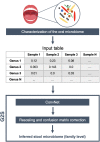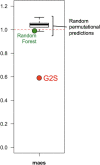G2S: A New Deep Learning Tool for Predicting Stool Microbiome Structure From Oral Microbiome Data
- PMID: 33897763
- PMCID: PMC8062976
- DOI: 10.3389/fgene.2021.644516
G2S: A New Deep Learning Tool for Predicting Stool Microbiome Structure From Oral Microbiome Data
Abstract
Deep learning methodologies have revolutionized prediction in many fields and show the potential to do the same in microbial metagenomics. However, deep learning is still unexplored in the field of microbiology, with only a few software designed to work with microbiome data. Within the meta-community theory, we foresee new perspectives for the development and application of deep learning algorithms in the field of the human microbiome. In this context, we developed G2S, a bioinformatic tool for taxonomic prediction of the human fecal microbiome directly from the oral microbiome data of the same individual. The tool uses a deep convolutional neural network trained on paired oral and fecal samples from populations across the globe, which allows inferring the stool microbiome at the family level more accurately than other available approaches. The tool can be used in retrospective studies, where fecal sampling was not performed, and especially in the field of paleomicrobiology, as a unique opportunity to recover data related to ancient gut microbiome configurations. G2S was validated on already characterized oral and fecal sample pairs, and then applied to ancient microbiome data from dental calculi, to derive putative intestinal components in medieval subjects.
Keywords: deep learning; gut microbiome; microbiome; oral microbiome; paleomicrobiology.
Copyright © 2021 Rampelli, Fabbrini, Candela, Biagi, Brigidi and Turroni.
Conflict of interest statement
The authors declare that the research was conducted in the absence of any commercial or financial relationships that could be construed as a potential conflict of interest.
Figures





Similar articles
-
Oral Paleomicrobiology: Study of Ancient Oral Microbiome.J Contemp Dent Pract. 2015 Jul 1;16(7):588-94. doi: 10.5005/jp-journals-10024-1726. J Contemp Dent Pract. 2015. PMID: 26329415 Review.
-
Human Gut Microbiome Aging Clock Based on Taxonomic Profiling and Deep Learning.iScience. 2020 Jun 26;23(6):101199. doi: 10.1016/j.isci.2020.101199. Epub 2020 May 23. iScience. 2020. PMID: 32534441 Free PMC article.
-
Predicting Host Phenotype Based on Gut Microbiome Using a Convolutional Neural Network Approach.Methods Mol Biol. 2021;2190:249-266. doi: 10.1007/978-1-0716-0826-5_12. Methods Mol Biol. 2021. PMID: 32804370 Review.
-
MegaD: Deep Learning for Rapid and Accurate Disease Status Prediction of Metagenomic Samples.Life (Basel). 2022 Apr 30;12(5):669. doi: 10.3390/life12050669. Life (Basel). 2022. PMID: 35629336 Free PMC article.
-
Altered Fecal Small RNA Profiles in Colorectal Cancer Reflect Gut Microbiome Composition in Stool Samples.mSystems. 2019 Sep 17;4(5):e00289-19. doi: 10.1128/mSystems.00289-19. mSystems. 2019. PMID: 31530647 Free PMC article.
Cited by
-
BowSaw: Inferring Higher-Order Trait Interactions Associated With Complex Biological Phenotypes.Front Mol Biosci. 2021 Jun 17;8:663532. doi: 10.3389/fmolb.2021.663532. eCollection 2021. Front Mol Biosci. 2021. PMID: 34222331 Free PMC article.
-
From the nose to the lungs: the intricate journey of airborne pathogens amid commensal bacteria.Am J Physiol Cell Physiol. 2022 Oct 1;323(4):C1036-C1043. doi: 10.1152/ajpcell.00287.2022. Epub 2022 Aug 29. Am J Physiol Cell Physiol. 2022. PMID: 36036448 Free PMC article. Review.
-
Over-feeding the gut microbiome: A scoping review on health implications and therapeutic perspectives.World J Gastroenterol. 2021 Nov 7;27(41):7041-7064. doi: 10.3748/wjg.v27.i41.7041. World J Gastroenterol. 2021. PMID: 34887627 Free PMC article.
-
Deep learning methods in metagenomics: a review.Microb Genom. 2024 Apr;10(4):001231. doi: 10.1099/mgen.0.001231. Microb Genom. 2024. PMID: 38630611 Free PMC article. Review.
-
Deep learning in microbiome analysis: a comprehensive review of neural network models.Front Microbiol. 2025 Jan 22;15:1516667. doi: 10.3389/fmicb.2024.1516667. eCollection 2024. Front Microbiol. 2025. PMID: 39911715 Free PMC article. Review.
References
-
- Bishop C. M. (2016). Pattern Recognition and Machine Learning. New York, NY: Springer.
LinkOut - more resources
Full Text Sources
Other Literature Sources

